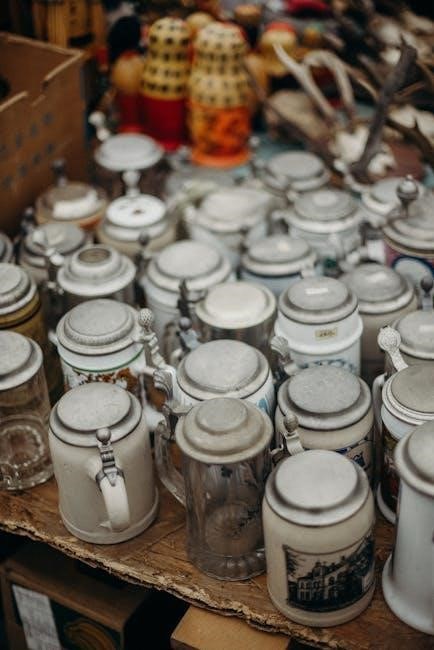beer stein value guide
Beer steins are cherished collectibles with rich historical and cultural significance, often crafted from materials like stoneware, ceramic, or pewter. Their value is influenced by rarity, age, condition, and craftsmanship, making them highly sought after by enthusiasts for their artistic and historical appeal.
What is a Beer Stein?
A beer stein is a traditional German drinking vessel, often made of stoneware, ceramic, glass, wood, or pewter. Originating in the 14th century, it features a lid, typically made of pewter, designed to keep dust and insects out. The term “stein” comes from the German word for “stone,” reflecting its early stoneware construction. Beer steins are known for their intricate decorations, often depicting folk tales, historical scenes, or patriotic themes. They come in various sizes, with traditional steins holding one liter, and are prized for their craftsmanship and cultural significance, making them both functional and collectible items.
Historical Significance of Beer Steins
Beer steins hold deep historical significance, tracing back to 14th-century Germany when they were crafted as practical drinking vessels. Their design evolved from simple stoneware mugs to intricately decorated pieces, reflecting cultural and artistic trends. The introduction of pewter lids during the Black Death era was a sanitary innovation. Over centuries, steins became symbols of German heritage, often depicting folk tales and patriotic scenes. They played roles in military and social contexts, with regimental steins honoring soldiers. Today, they are cherished collectibles, bridging history, craftsmanship, and tradition, offering insights into Germany’s rich cultural and historical tapestry.
Historical Background
Originating in 14th-century Germany, beer steins evolved from practical stoneware mugs to ornate vessels, influenced by historical events like the Black Death and World Wars, shaping their design and production over centuries.
Origins of Beer Steins in Germany
German beer steins trace their origins to the 14th century, emerging as a response to the need for sanitary drinking vessels during the Black Death. Initially crafted from stoneware, these early steins featured pewter lids to prevent contamination. The upper class favored silver, glass, and pewter mugs, while commoners used wood and earthenware. The invention of stoneware in Germany marked a significant milestone, leading to the production of durable, lid-topped steins that became iconic in German culture and tradition, symbolizing both practicality and craftsmanship.
Evolution of Beer Stein Design Over the Centuries
Beer stein design has evolved significantly over the centuries, reflecting technological advancements and cultural shifts. Early steins featured pewter lids and simple stoneware bodies, while later designs incorporated intricate pewterwork and ornate decorations. By the 19th century, ceramic and glass steins gained popularity, with regional variations emerging. The 20th century saw the rise of mass-produced steins using molds, which reduced craftsmanship but made them more accessible. Modern steins often blend traditional motifs with contemporary materials, preserving historical themes while appealing to new generations of collectors and enthusiasts.
Impact of Historical Events on Beer Stein Production
Historical events significantly influenced beer stein production, shaping both design and availability. The Black Death spurred the creation of covered steins to prevent contamination. World War I caused a decline in production due to resource shortages, while World War II saw a resurgence with modern manufacturing techniques. The rise of industrialization in the 19th century enabled mass production, making steins more accessible. Each era left its mark, with designs reflecting cultural and political shifts, thereby affecting the value and rarity of steins for collectors today.
Factors Influencing Value
The value of beer steins is determined by rarity, age, material quality, craftsmanship, condition, and market demand. These factors collectively influence their worth in the collector’s market.
Rarity and Age of the Beer Stein
Rarity and age significantly impact the value of beer steins, with older, harder-to-find pieces commanding higher prices. Steins from the 14th to 19th centuries are particularly rare and valuable. Limited editions or those tied to historical events, such as military regimental steins, are highly sought after. The age of a stein can be determined through markings, design styles, and historical context. For example, a 17th-century Meissen stein sold for $140,000, showcasing the premium placed on antiquity. The scarcity of certain designs or production periods further enhances their desirability among collectors.
Material and Craftsmanship Quality
Material and craftsmanship are key factors in determining a beer stein’s value. Steins made from high-quality stoneware, pewter, or porcelain are more valuable than those crafted from common materials. Intricate designs, hand-painted details, and ornate pewterwork indicate superior craftsmanship, increasing a stein’s worth. For instance, steins with inlaid lids or hand-carved elements are highly prized. The skill of the artisan and the attention to detail in the manufacturing process also play a significant role in appraisals. Additionally, the use of rare or luxurious materials can elevate a stein’s value, making it a standout piece among collectors.
Condition and Preservation of the Stein
The condition of a beer stein significantly impacts its value. Steins in excellent condition, with minimal wear or damage, are highly sought after by collectors. Chips, cracks, or faded designs can reduce a stein’s worth, while well-preserved pieces retain or increase in value. Proper cleaning and storage are essential to maintain condition. Restoration should be approached cautiously, as it may lower authenticity. Collectors often prefer original, untouched steins, as they reflect the craftsmanship and history of the piece. Preserving a stein’s integrity ensures its value endures, making it a treasured addition to any collection.

Market Demand and Popularity
Market demand plays a crucial role in determining the value of beer steins. Popularity often drives up prices, with certain designs, such as limited editions or historically significant steins, being highly sought after. Collectors are willing to pay premium prices for rare or unique pieces, especially those with intricate craftsmanship or historical ties. Trends in the market can fluctuate, but steins with cultural or nostalgic appeal consistently attract buyers. As a result, understanding current demand is essential for both collectors and sellers to navigate the market effectively and make informed decisions.


Identifying Authenticity
Authenticity is key to determining a beer stein’s value. Look for markings, signatures, and craftsmanship quality. Genuine steins often feature unique designs and historical themes, ensuring their legitimacy and appeal to collectors.
Understanding Markings and Signatures
Markings and signatures are crucial for identifying authentic beer steins. They often include manufacturer logos, model numbers, and production dates. For instance, stamps like “Made in Germany” or specific maker’s marks can indicate origin and authenticity. Hand-painted signatures or intricate designs may signify craftsmanship. Additionally, calibration marks show the stein’s capacity, ensuring it meets historical standards. These details not only verify legitimacy but also enhance the stein’s value, making them essential for collectors to recognize and interpret.
Differentiating Authentic from Reproduction Steins
Authentic beer steins often feature unique markings, hand-painted details, and minor imperfections, while reproductions lack these nuances. Genuine steins may have maker’s marks, historical scenes, or patriotic themes, reflecting their craftsmanship. Reproduction steins, however, are mass-produced with uniform designs and lack the human touch. Examining the material quality, lid construction, and handle details can help identify authenticity. Additionally, authentic steins often come with certificates or provenance, adding to their legitimacy. Collectors should look for these distinguishing factors to ensure they acquire a true piece of history rather than a modern replica.
Role of Certificates of Authenticity
Certificates of authenticity play a crucial role in verifying the legitimacy of beer steins, especially for newer or limited-edition pieces. These documents, often issued by manufacturers or appraisers, provide detailed information about the stein’s origins, materials, and production date. They enhance trust and credibility, making the stein more desirable to collectors. While not all authentic steins come with certificates, their presence significantly boosts value and assures buyers of the item’s genuineness. However, it’s important to ensure the certificate is from a reputable source, as counterfeit documents can mislead collectors.
Types of Beer Steins
Beer steins come in various types, including antique, vintage, and modern designs, crafted from materials like stoneware, ceramic, glass, wood, and pewter. Regional variations and specialty steins, such as limited editions and commemorative designs, add diversity to collections.
Antique vs. Vintage vs. Modern Steins
Antique steins, typically dating pre-1900, are highly prized for their historical significance and craftsmanship. Vintage steins, from the early to mid-20th century, often feature intricate designs and are sought after by collectors. Modern steins, produced with contemporary techniques, offer a blend of traditional and innovative designs. Each category holds unique value, with antiques commanding higher prices due to rarity and age, while modern steins appeal for their accessibility and artistic flair. Understanding these distinctions aids collectors in appreciating the diverse appeal of beer steins across different eras.
Regional Variations in Design and Material
Regional variations in beer steins reflect local craftsmanship and cultural influences. German steins often feature stoneware with pewter lids, while Bavarian designs emphasize traditional folk art. Ceramic steins from the Rhineland may incorporate vibrant colors and historical scenes. In contrast, modern manufacturers use diverse materials like glass and porcelain, blending traditional motifs with contemporary aesthetics. These regional differences not only enhance the steins’ uniqueness but also impact their value, as certain designs and materials are more sought after by collectors. Such variations highlight the rich diversity within beer stein craftsmanship and cultural heritage.
Specialty Steins: Limited Editions and Commemorative Designs
Specialty steins, such as limited editions and commemorative designs, hold unique appeal for collectors. These steins are often crafted to mark significant events, anniversaries, or cultural themes, featuring intricate artwork and exclusive designs. Limited editions, produced in small quantities, tend to appreciate in value over time due to their rarity. Commemorative steins, honoring historical figures or milestones, offer both sentimental and monetary worth. Their distinctiveness and historical significance make them highly desirable, often commanding premium prices in the market. These special steins are treasured not only for their beauty but also for the stories they tell.

Notable Manufacturers

Trusted brands like KING, Thewalt, Zoeller, and Born and Zimmerman produce authentic German beer steins, with their reputation significantly influencing the value and desirability of their pieces.
Historic and Contemporary Manufacturers
Historic manufacturers like Reinhold Hanke and Villeroy & Boch have shaped the legacy of beer steins, while contemporary brands continue to innovate. These companies are known for their exceptional craftsmanship and attention to detail, ensuring each stein is a masterpiece. Their reputation plays a crucial role in determining the value of their pieces, making them highly sought after by collectors. The combination of tradition and modern techniques ensures that their steins remain timeless and valuable, appealing to both seasoned collectors and new enthusiasts alike in the market.
Impact of Manufacturer Reputation on Value
The reputation of a manufacturer significantly influences the value of beer steins. Renowned brands like Villeroy & Boch and Reinhold Hanke are prized for their exceptional craftsmanship and historical significance, commanding higher prices. Steins from these manufacturers often feature intricate designs, high-quality materials, and attention to detail, making them more desirable to collectors. The historical legacy and trust associated with these names enhance their market value, ensuring they remain sought after and highly valued in auctions and private sales. This reputation-driven appeal underscores the importance of provenance in determining a stein’s worth.
Identifying Marks of Renowned Makers
Identifying marks of renowned beer stein makers is crucial for authentication and valuation. Manufacturers like Villeroy & Boch and Thewalt often imprint their logos, model numbers, or signatures on the base. These marks may include stamps, etchings, or raised patterns, providing proof of origin. For instance, Villeroy & Boch’s Mettlach steins feature distinctive mold numbers and “Mettlach” inscriptions. Similarly, Thewalt steins often bear the maker’s name and a crown symbol. These identifying marks not only verify authenticity but also enhance the stein’s value, making them highly sought after by collectors and connoisseurs in the market.
Auction Records and Sales
Beer steins have fetched remarkable prices at auctions, with a 17th-century Meissen stein selling for $140,000. Most steins range between $50 and $5,000, but rare pieces exceed this, driven by historical significance and collector demand.
Most Valuable Beer Steins Ever Sold
The most valuable beer steins ever sold highlight the pinnacle of craftsmanship and rarity. A 17th-century Meissen beer stein sold for $140,000, setting a record for its historical significance and exquisite design. Another notable example is a 19th-century Merkelbach & Wicki stein, fetching over $100,000 due to its intricate pewterwork and limited production. A rare Regimental stein from World War I sold for $50,000, its value bolstered by its military history and hand-painted details. These sales underscore the importance of age, condition, and provenance in determining a stein’s worth, making them true treasures for collectors.
Notable Auction Houses for Beer Stein Sales
Prominent auction houses like Christie’s and Sotheby’s frequently feature rare beer steins, attracting global collectors. Heritage Auctions and Bonhams also host specialized sales, offering historic and limited-edition pieces. These platforms ensure authenticity and provide detailed provenance, enhancing trust among bidders. Regional European auction houses, particularly in Germany, are also key players, showcasing steins with cultural significance. Online platforms like eBay and specialized collectible sites further expand accessibility, connecting sellers with a broader audience. These auction houses play a crucial role in setting market standards and facilitating high-value transactions in the beer stein collector community.
Trends in Beer Stein Auction Markets
Recent trends in beer stein auctions highlight a surge in demand for rare, 19th-century German steins, particularly those with intricate pewterwork and historical themes. Limited-edition and commemorative steins are gaining traction, with prices increasing steadily. Online platforms are driving accessibility, attracting younger collectors. Additionally, there’s a growing interest in steins with military or folk-art motifs, reflecting a desire for items with storytelling potential. Auction houses report higher bids for pieces with documented provenance, underscoring the importance of authenticity. This upward trend suggests a vibrant, evolving market where rare and unique steins continue to captivate enthusiasts and investors alike.

Rare and Unique Steins
Rare and unique steins are highly prized for their exceptional craftsmanship, historical significance, and limited availability, often featuring intricate designs and materials that set them apart from common pieces.
Characteristics of Rare Beer Steins
Rare beer steins often feature intricate designs, such as hand-painted scenes, ornate pewter lids, and unique motifs. They may include historical or cultural themes, like military insignias or folk tales. Limited-edition steins, especially those with maker’s marks or signatures, are highly sought after. The materials used, such as high-quality stoneware or porcelain, and the craftsmanship, like mold-made or hand-carved details, contribute to their rarity. Additionally, steins with provenance, such as those tied to significant events or ownership by notable individuals, can significantly enhance their value and desirability among collectors.
Historical and Cultural Significance of Rare Steins
Rare beer steins hold profound historical and cultural value, often reflecting the era in which they were crafted. Many date back to the 14th century, influenced by events like the Black Death, which spurred the creation of covered steins for hygiene. Military steins, adorned with regimental insignias, honor soldiers’ bravery, while others depict traditional German folklore and patriotic scenes. These steins serve as windows into Germany’s rich heritage, capturing its artistic evolution and societal values. Their cultural significance is further enhanced by their role in celebrations like Oktoberfest, making them treasured artifacts for collectors and historians alike.
Exceptional Craftsmanship in Unique Steins
Unique steins showcase extraordinary craftsmanship, often featuring intricate designs and artistic mastery. Hand-painted details, ornate pewterwork, and elaborate relief carvings highlight the skill of their creators. Limited-edition and commemorative steins, such as those produced by renowned manufacturers like KING and Thewalt, exemplify exceptional artistry. These pieces often incorporate rare materials and techniques, making each stein a one-of-a-kind treasure. The attention to detail and historical accuracy in their design contribute to their value, appealing to discerning collectors who appreciate both beauty and historical significance.

Tips for Collectors
Start by researching markings and authenticity to identify valuable steins. Focus on condition, rarity, and craftsmanship. Consider certificates of authenticity to ensure legitimacy and maximize value.
How to Start a Beer Stein Collection
Starting a beer stein collection begins with research and understanding what makes a stein valuable. Look for authentic pieces with clear markings, such as manufacturer stamps or historical designs. Begin with modern or vintage steins that fit your budget and interests. Consider focusing on a specific theme, like regional designs or military steins, to build a cohesive collection. Set a budget and prioritize condition, as damage can significantly reduce value. Join collector communities or consult experts to gain insights and avoid counterfeits. Finally, store your steins properly to preserve their condition and longevity.
Strategies for Buying and Selling Steins
When buying steins, prioritize authenticity by examining markings, materials, and craftsmanship. Research reputable sellers and compare prices to ensure fair value. For selling, highlight the stein’s rarity, condition, and historical significance in listings. Use high-quality images and detailed descriptions to attract serious buyers. Consider consigning to auction houses or specialized dealers for higher-value steins. Timing is crucial; sell during peak collector interest or seasonal events like Oktoberfest. Additionally, keep records of provenance and any restoration work to enhance credibility and appeal to potential buyers.
Maintaining and Preserving Your Collection
Maintaining and Preserving Your Collection
To preserve your beer steins, avoid harsh chemicals and abrasive cleaners, as they can damage materials and finishes. Use mild soap and soft cloths for cleaning. Store steins in a cool, dry place away from direct sunlight to prevent fading. Avoid extreme temperatures, as they can crack or warp the steins. For restoration, consult professionals to maintain authenticity and value. Display steins on stable surfaces or in glass-front cabinets to protect from dust and damage. Handle with care, as chips or cracks can significantly reduce value. Regular inspection and gentle maintenance ensure your collection remains pristine for generations.

Cultural Significance
Beer steins embody German heritage, symbolizing tradition and craftsmanship. They are integral to celebrations like Oktoberfest, reflecting cultural identity and storytelling through intricate designs and historical motifs.
Role of Beer Steins in German Culture
Beer steins are deeply rooted in German culture, serving as both functional drinkware and symbolic artifacts. Originating in the Middle Ages, they became essential in taverns and festivals, embodying Gemütlichkeit, or conviviality. Steins often feature patriotic scenes, folklore, and historical motifs, reflecting national pride and storytelling traditions. Their presence in Oktoberfest and other celebrations underscores their role in fostering social bonds and preserving heritage. Beyond their practical use, steins are cherished for their artistic craftsmanship and historical significance, making them a cornerstone of German cultural identity and tradition.
Beer Steins in Military and Social Contexts
Beer steins hold significant meaning in both military and social settings. Regimental steins, often presented to soldiers, feature intricate designs and personalized engravings, symbolizing honor and camaraderie. These steins frequently depict patriotic scenes or military motifs, making them highly collectible. In social contexts, steins are central to festivals and gatherings, fostering a sense of community and tradition. Their use in celebrations like Oktoberfest highlights their role in German social culture, while military steins carry sentimental value, often passed down through generations. This dual significance enhances their appeal and value among collectors and historians alike.
Steins as Symbols of Tradition and Heritage
Beer steins embody deep cultural heritage, serving as tangible links to Germany’s rich history. Their intricate designs often depict folk tales, historical events, and regional motifs, preserving traditions and storytelling. Crafted with precision, steins reflect the artistic mastery of German artisans, making them cherished heirlooms. They are not just drinking vessels but symbols of identity and pride, passed through generations. This cultural significance elevates their value, appealing to both collectors and those who appreciate their historical depth. Steins truly capture the essence of German tradition, blending artistry with heritage in every detail.
Care and Maintenance
Proper care ensures beer steins retain their value and longevity. Use mild detergents, avoid abrasive materials, and store in a cool, dry place. Handle with care to prevent damage and preserve their historical charm for future generations.
Best Practices for Cleaning and Storing Steins
Cleaning and storing beer steins requires careful attention to preserve their condition and value. Use mild soap and warm water, avoiding harsh chemicals or abrasive materials that could damage finishes or etchings. Dry thoroughly to prevent water spots. Store steins in a cool, dry place away from direct sunlight to avoid fading. For display, use acid-free materials or padded shelves to prevent scratching. Avoid stacking steins to minimize risk of chipping or cracking. Regular maintenance ensures your collection remains pristine and retains its value over time.
Restoration vs. Preservation: What Collectors Should Know
Restoration and preservation are critical considerations for beer stein collectors. Restoration involves repairing or altering a stein to enhance its appearance, which can sometimes reduce its historical authenticity. Preservation focuses on maintaining the stein’s original condition, even if it means leaving minor flaws intact. Collectors should weigh the importance of maintaining historical integrity against the desire for aesthetic perfection. Professional conservators can provide guidance, ensuring that any work respects the stein’s heritage. The goal is to balance maintaining value while honoring the craftsmanship and history embedded in each piece.
Preventing Damage and Extending Lifespan
To preserve your beer stein’s value and longevity, proper care is essential. Avoid exposure to extreme temperatures or harsh chemicals, as these can damage materials like pewter or ceramic. Clean steins gently with mild soap and water, avoiding abrasive materials that might scratch surfaces. Store them in a cool, dry place, away from direct sunlight to prevent fading. For display, use sturdy stands or shelves to minimize handling and risk of breakage. Regular inspection can help catch minor issues before they become major problems, ensuring your collection remains pristine for generations.

Conclusion
Beer steins are timeless collectibles, blending history, artistry, and cultural heritage. Their value lies in rarity, craftsmanship, and condition, making them cherished investments for enthusiasts and historians alike.
Final Thoughts on Beer Stein Collecting
Beer stein collecting is a rewarding hobby that combines history, art, and culture. Enthusiasts appreciate these pieces for their craftsmanship and historical significance. Understanding markings, materials, and rarity is key to valuing steins. Whether you’re a seasoned collector or just starting, each stein tells a story, making every addition to your collection unique and meaningful. By focusing on authenticity and condition, collectors can build a valuable and cherished assortment that honors the tradition of German beer culture and the artistry behind these iconic mugs.
Future of Beer Stein Collecting and Value Appreciation
The future of beer stein collecting looks promising, with increasing interest in rare and unique pieces. As historical items gain recognition, their value is expected to rise, driven by demand from both seasoned collectors and newcomers. Limited editions and commemorative designs are particularly sought after, suggesting sustained growth in the market. Additionally, advancements in authentication techniques and digital platforms may enhance accessibility and transparency, further fueling the appreciation of these treasured collectibles. Collectors can anticipate a vibrant and evolving hobby with potential for significant returns on investment.

